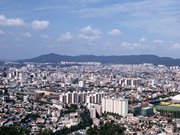Daejeon
|
|
Template:Infobox Korean city Daejeon Metropolitan City is a metropolitan city in the centre of South Korea, and the capital of South Chungcheong Province. It is the fifth largest city of South Korea with a population of 1,438,778 at the end of the year of 2003.
| Contents |
History
Before Gyeongbu railway passed through Daejeon, it was a small field called Hanbat. In 1905 Gyeongbu railway started to transport; a station was built on the way from Seoul to Busan. Soon Honam railway was built to split at Daejeon. In 1932, the capital of Chungnam province moved from Gongju to Daejeon.
Geography
Latitude : N 36° 10' 50" ~ 36° 29' 47", Longitude : E 127 14' 54" ~ 127 33' 21"
For Daejeon is located in the middle of South Korea, it's the gateway to Yeongnam and Honam. It's 167.3km from Seoul, 294km from Busan and 169km from Gwangju.
Transportation
Daejeon is the center of transportation, two highway backbones, Gyeongbu highway and Honam highway join in Daejeon and two major railways, Gyeongbu railway and Honam railway meet in Daejeon. KTX passes through Daejeon, it takes less than one hour from Daejeon to Seoul. Daejeon is served by Cheongju Airport which is north of Cheongju.
Culture
In 1993, an international exposition (Expo '93) was held at Daejeon, and the EXPO Bridge was built for the event.
The city is also home to K-League soccer club Daejeon Citizen, and is also the hometown of women's golf great Se Ri Pak.
Daejeon Museum of Art, located in Dunsan Park, is one of the most great art museums in Korea. Since it was established in 1998, it has been holding numerous exhibitions on the Contemporary Art. Especially it is focused on the convergence of Art and Technology. As Daejeon is the very city with Daeduk Science and Research Complex, Kaist, and a lot of research centers, DMA aims at the center of new art concentrating on the new technology. DMA will hold the huge art festival on coming October, including the main exhibition titled <<Digital Paradise>>(DMA, Oct. 14~Dec.18).
Downtown
Daejeon has become the recipient of the country's effort to decentralize certain ministries of the national government. The middle of the city or the new downtown called Dunsan is where the effort has manifested itself. Newer, shiner, albeit structurally similar apartment complexes to that of the rest of the city, sprung up around the new government structures being constructed concurrently in just a few short years starting from the mid-1990s. Newer municipal buildings including the city's courts and the province's main parliamentary building soon followed. The result is a several square mile neighbourhood full of restaurants, standard Korean western-type bars and coffee shops. The area is a place for the workers of the new Daejeon to live close to their offices, most able to walk to work, and dine and shop in a new urban environment.
Administrative divisions
Daejeon is divided into 5 wards ("Gu").
| Name | Hangul | Hanja |
| Daedeok-gu | 대덕구 | 大德區 |
| Dong-gu | 동구 | 東區 |
| Jung-gu | 중구 | 中區 |
| Seo-gu | 서구 | 西區 |
| Yuseong-gu | 유성구 | 儒城區 |
See also
External link
Expobridge.jpg
| Administrative divisions of South Korea | 
|
|---|---|
| Special City Seoul | |
| Metropolitan Cities Busan | Daegu | Daejeon | Gwangju | Incheon | Ulsan | |
| Provinces North Chungcheong | South Chungcheong | Gangwon | Gyeonggi | North Gyeongsang | South Gyeongsang | Jeju | North Jeolla | South Jeolla | |

